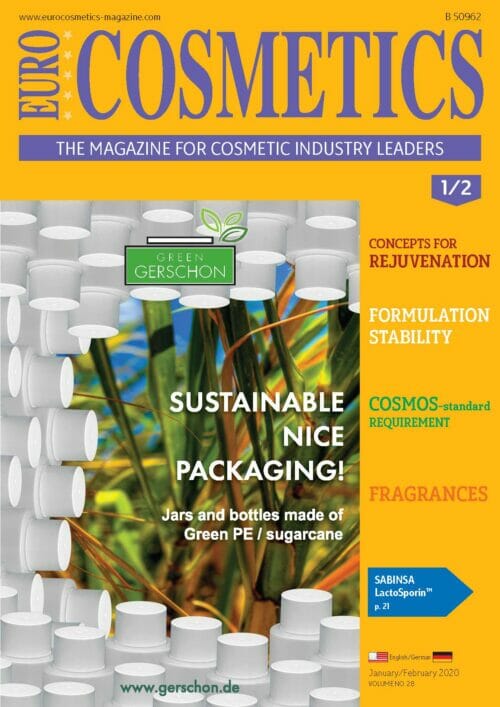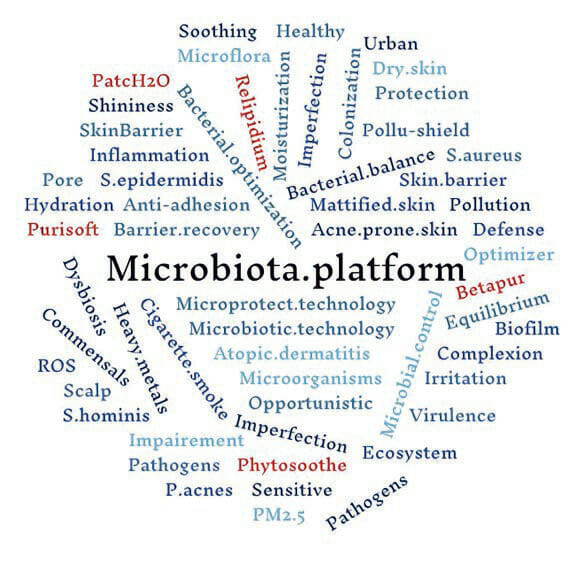
Editor’s Note:
Much has been written about environmental pollution and its impact on skin. This article stands head and shoulder above many of these because it actually measures the impact of specific factors deriving from various types of environmental pollution on the microbiome existing on skin of different types. A refreshing, creative, in-depth probe of the rapidly growing interest in the impact of environmental stressors on the skin’s microbiome.
Enjoy the read!
Consumers of skin care products are concerned by the potential damage that external factors (antibacterial agents, pollution, UV exposure etc) can cause to their skin health for the long-term.
They increasingly prefer products that not only address cosmetic concerns like fine line reduction or moisturization, but that also preserve or improve skin health.
From birth, the skin surface is colonized by the microbiota: a microflora composed of bacteria, yeasts, fungi and viruses. This invisible, but abundant microbiota can reach up to one million microorganisms per cm². Its composition continues to evolve throughout life, depending on the skin conditions (water, pH, lipids, proteins) or depending on the skin environment (temperature, sun exposure). Moreover, among all countries, regardless of socio-demographic index level, instances of skin and subcutaneous diseases correlated with microbiota imbalance, such as psoriasis, dermatitis, acne vulgaris and fungal diseases are increasing Consequently, consumers are shifting their interests and purchases towards using skin care products which incorporate prebiotics, probiotics and/or biome-friendly components. These products address the root cause of microbiome imbalance. In the never-ending search for appealing new products, the cosmetic industry is being empowered to acquire new data and knowledge on the ecosystem of the skin microbiota in order to shift the direction of their research towards the development of new products.
At present, probiotics and the microbiome are the biggest drivers in the growth of science-based skin care products 2. It is likely that this growth will persist in the coming years.
Introduction to the “Microbiota Platform”
To further explore the role of microbiota in a healthy skin, and at first on the skin barrier, we established a few years ago an interdisciplinary innovation platform called “Microbiota Platform”. Understanding the role of some key micro-organisms on skin beauty,and building new models to study the effects of skin care bio-actives, required new capabilities. To this end, we reinforced our research facilities and entered into partnerships with recognized scientific experts from public and private research institutes.
We particularly developed in vitro models to study the complexity of skin microflora and its ecosystem to help us to design more specific solutions, better adapted to each and every skin
condition.
At first, to evaluate bacterial relative growth and their interactions, we developed in-tubo co-cultures models of up to the 4 relatively abundant species in appropriate culture conditions: Propionibacterium acnes, Staphylococcus epidermidis, Staphylococcus aureus and Staphylococcus hominis. P acnes sp and Staphylococus sp are the most abundant species found on the skin which are involved in the maintenance of the skin microbiome equilibrium and some skin conditions (P. acnes: acnea, and S. aureus: atopic dermatitis ).
We used a specifically designed quantitative polymerase chain reaction to identify and quantify specific genes for each microorganism, to quantify them after 2 days. With these culture models,
we were able to select a plant extract favoring the growth of commensal bacteria (S. epidermidis and S. hominis) to the detriment of pathogenic bacteria (S. aureus and P. acnes) (Figure 1). These observations could be potentially explained by the secretion of antimicrobial and quorum sensing molecules 3–5.

Pollution affects skin beauty, quality and health. It induces dryness, premature aging, hyperpigmentation, dull skin and irritation. However, bacteria on the surface of our skin and mucous layers are the first to encounter the harmful elements of smog created through the interactions between pollutants in the air, fog, and sunlight. The reactive oxygen species (ROS) formed under such conditions interact with the skin and its microflora and subsequently damage proteins, DNA and lipids. This eventually leadsto cell and microorganisms death 6.
Exposure of the human skin to ozone also leads to a 50% reduction in the resident skin microflora. Acneic skin conditions are known to be worsened in a polluted environment as well 7–8.
Therefore, it makes sense to evaluate the impact of particulate matter present in polluted environment on skin microbiota and to select skin care bio-actives able to improve microbial balance in order to achieve the goal of improved skin health. For this purpose, we evaluated the efficacy of a hydrating an antipollution protective active complex namely PatcH2O® in a protocol that combines particulate matter exposure (1649b particles at 2.5 mg/ mL) together with S. epidermidis and P. acnes grown separately in-tubo (Figure 2).

The strong impact of pollutants on bacterial growth was confirmed in polluted conditions. While the skin care bio-active induced a significant protection of the beneficial S. epidermidis growth (x1.5 vs polluted control), a slight decrease was observed for P. acnes. Parallel experimentation uncovered that PatcH2O® demonstrated in vitro antioxidant and anti-inflammatory properties, increased keratinocytes viability, and reduced by 43% the pollution remanence on synthetic skin (Vitroskin®) after washing. Interestingly, as urban skin generally suffers from dehydration, and as dry skin is more prone to S. aureus colonization, this bioactive also limited S. aureus growth and biofilm formation using BioFilm Ring Test® (data not shown). Favoring S. epidermidis over of P. acnes and S. aureus, PatcH2O® acts as a Micro-Protect Technology that could help stressed skin to recover a healthier microbiote profile.
Considering the encouraging data reported above, if the multimicroorganism’ studies evidence microbial competition and provide information about the skin care bio-active specificity, such interesting properties still had to be confirmed in the presence of skin cells, because the skin and its microbiota share multiple interactions.
To learn more about these interactions in physiological models, we developed several incremental cellular methods. Further to our cooperation with the International Center for Infectiology Research (Lyon, France), we developed our novel and most advanced three-dimensional full thickness organotypic skin model.
At first, we evaluated the effect of a postbiotic (Relipidium™: yeast extract biofermented by Lactobacillus plantarum) on the secretion of IL-8 by keratinocytes in the presence of S. aureus. Originally selected for its ability to boost the synthesis of epidermal lipids, this bio-active contributes to improve skin comfort by reducing microbial-induced inflammation (Figure 3).

(Relipidium™).
Secondly, in order to better understand the relation between sebum production, sebum oxidation, and bacterial colonization in acne prone skin, we developed a model to study the synergistic harmful effect of UV and P. acnes on sebocyte cultures. Our results clearly showed that UVA (the UV that penetrates deeper in the dermis, where pilosebaceous units and sebocytes are located) strongly enhanced the oxidative stress (MDA release) in human sebocytes infected by P. acnes and that this oxidative stress could be counterbalanced by EGCG (positive control epigallocatechin gallate) or a plant extract, for a daily skin care protection (Figure 4).

Thirdly, the 3D skin model developed by the experts of our Microbiota Platform was the first one succeeding in the co-culture of 2 different bacteria to study their relative adhesion, growth and impact on skin quality 9. In this 3D microbiotic skin model we observed that S. epidermidis grew at the skin surface and that P. acnes grew both at the skin surface but also deeper in the upper
layer of the epidermis likely because of its anaerobic respiratory system.
In the same model, we also identifed skin care bio-actives having different abilities to equalize the S. epidermidis /P. acnes balance. Some can: decrease the global microbial load, or specifically inhibit P. acnes, or decrease P. acnes while increasing S. epidermidis, thus leading to a more balanced skin microflora. Additionally, we observed a correlation between the level of virulence of skin microorganisms and the damage caused to the epidermis. For instance, as compared to S. epidermidis, S. aureus already damaged skin surface after only 1-day exposure (Figure 5).


Plotting both our Corneometer® and microbial data from this particular study allowed us to observe a global increase of S. epidermidis relative proportion in parallel with an increase of skin hydration (Figure 6A), as well as an increase of the S. aureus/S.epidermidis ratio in parallel with skin dryness in parts of volunteers bearing S. aureus on their skin (Figure 6B).
Finally, we set-up clinical protocols to study the complexity of skin microflora and skin ecosystem to help design more personalized solutions.
For example, the efficacy of formulation containing Relipidium ™ at 2% on skin microbiota and hydration was evaluated.
Twenty healthy caucasian women between 18 and 45 years old, having dry skin (Corneometer® Unit Value <52) applied the products twice a day on their face for 14 days. Corneometer® measurements and skin microbiota swabbing were performed on the cheek to evaluate hydration, while S. epidermidis, S. aureus and total bacterial flora (for normalization) were quantified using QPCR methods.

First, we showed that after 14 days of daily application of Relipidium™, the relative abundance of S. epidermidis determined as ratio of S. epidermidis population to the total bacteria population increased significantly vs D0 (2.1-fold, p<0.01). Surprisingly, we also observed that S. aureus was higher in dry skin: 50% of volunteers appeared to bear permanently S. aureus on their cheeks, while in normal skin the occurrence of S. aureus is reported to be lower than 20%, and particularly located in nares. Moreover, we also evidenced an increase in S. epidermidis relativeto S. aureus population between D0 and D14 (x2.3, p<0.1). On the same period, Relipidium™ significantly increased skin hydration by 11.5% after 14 days compared to the baseline.
In summary, through our “Microbiota Platform” we continuously acquire a deeper understanding of the interactions between the skin and its microbiota and open new territories and approaches for the cosmetic science of tomorrow.
References
- GBD 2015 Disease and Injury Incidence and Prevalence Collaborators. Global, regional, and national incidence, prevalence, and years lived with disability for 310 diseases and injuries, 1990–2015: a systematic analysis for the Global Burden of Disease Study 2015. Lancet. 388(10053):1545-1602, 2016.
- Roberts K, Euromonitor, The Microbiome in Skin Care: Challenges and Opportunities, August 2018
- Nakatsuji T, Chen TH, Narala S, Chun KA, Two A et al. Antimicrobials from human skin commensal bacteria protect against Staphylococcus aureus and are deficient in atopic dermatitis. Sci Transl Med. 9(378), 2017.
- Wang Y, Kao MS, Yu J, Huang S, Marito S, Gallo RL, Huang CM. A Precision Microbiome Approach Using Sucrose for Selective Augmentation of Staphylococcus epidermidis Fermentation against Propionibacterium acnes. Int J Mol Sci. 17(11), 2016.
- Canovas J, Baldry M, Bojer MS, Andersen PS, Grzeskowiak PK et al. Cross-Talk between Staphylococcus aureus and Other Staphylococcal Species via the agr Quorum Sensing System. Front Microbiol. 7:1733, 2016.
- Wong TY. Smog induces oxidative stress and microbiota disruption. J Food Drug Anal. 25(2):235-244, 2017.
- Mancebo SE, Wan SQ. Recognizing the impact of ambient air pollution on skin health. J Eur Acad Dermatol Venereol. 29(12): 2326–2332, 2015.
- Liu W, Pan X, Vierkötter A, Guo Q, Wang X et al. A Time-Series Study of the Effect of Air Pollution on Outpatient Visits for Acne Vulgaris in Beijing. Skin Pharmacol Physiol. 31(2):107-113, 2018.
- Cadau S, Valla-Dury L, Cenizo V, Le-beux C, Rival D, Gault M, Vianney A, Andre-Frei V. Studying microbiote competition and skin interaction using organotypic 3d skin models. ATROA 2017; 2(5).



